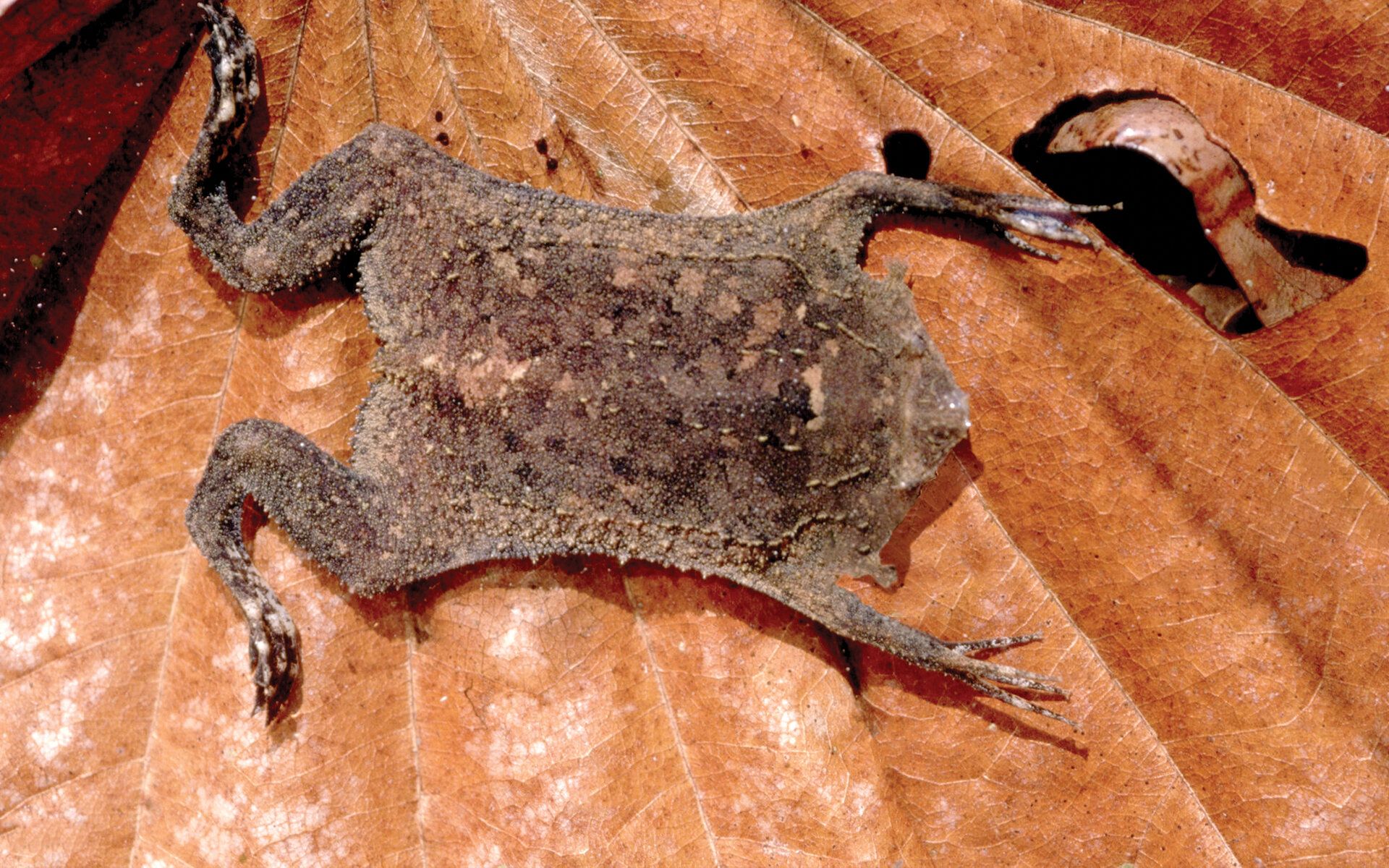Baby on Board

In This Article
-
The mother toad keeps its eggs on its back buried under its skin until they hatch and attain sufficient maturity. Thus, toadlets are embraced in an envelope of mercy in the most secure environment, safe from dangers.
-
The Surinam toad is a master of camouflage as it can be likened to a brown leaf floating in the water with its general structure and gray, brown, or olive color.
-
The eggs have to be buried within the skin of the female's back during the first 24 hours. To this end, the skin on the female's back starts to get thicker and be enriched with blood vessels just as the mother's womb is prepared for reproduction in mammalians.
The holy mystery called mercy embraces all beings. It is manifested in the most brilliant manner, particularly in the compassion of mothers. The mystery of mercy makes the mother's womb the first place for preparing an infant for their brief visit to this world. The mystery of mercy makes all resources in the mother's body available for the infant. Thanks to this mystery, specific processes, such as being able to produce breast milk, are specifically designed to satisfy all of the daily needs of the infant. Every moment, this mystery of mercy is woven into the very fabric of life, including the eternal life.
Just as human beings are equipped with reason and willpower and these attributes are always mirrors of mercy, mothers of unconscious living beings exhibit pictures of mercy. One of these beings is the Surinam toad (Pipa pipa), which carries its eggs on its back and makes its young go out of its skin. In this scene of divine wisdom, the mother toad keeps its eggs on its back buried under its skin until they hatch and attain sufficient maturity. Thus, toadlets are embraced in an envelope of mercy in the most secure environment, safe from dangers.
Pipa pipa is a toad in the family Pipidae. This interesting animal is prevalent in northern parts of South America. Although its name refers to Surinam, this toad lives also in countries neighboring Surinam as well. In particular, it lives in tropical and subtropical rain forests, muddy ponds, swamps, and certain rivers in Bolivia, Brazil, Colombia, Equator, Guyana, Peru, Trinidad and Tobago, and Venezuela.
General physical characteristics
This toad derives its name from its shape. Its body is completely flat. It appears as if it has been crushed in an accident. Unlike other frogs, it does not stand up on its rear feet. This gives it its flattened form. Its head is triangular and its wide body is like a thin pentagon. In Spanish, pipa means a "kite." Indeed, when viewed from above, the toad's shape is like that of a kite. While its average length varies between 10 and 13 cm, specimens that are as long as 20 cm were also reported. Male toads are smaller in size than female ones but their front legs are thicker. The eyes of Surinam toads are black and small. They have no eyelids, teeth, or tongue.
There are star-shaped extensions at the end of long arms of their front legs. Therefore, they are also referred to as the “star-fingered toad.” At the tip of these star structures are fibers which are very sensitive to touch. Compared to front legs, rear legs are stronger because they are used to push the animal forward. Likewise, its rear legs are webbed and very large. It is observed that male frogs frequently fight with each other using their heads and front legs.
The Surinam toad is a master of camouflage as it can be likened to a brown leaf floating in the water with its general structure and gray, brown, or olive color. Thanks to its pale color, flat body, and the fact that they generally lay motionless on the ground they are perceived as a plant fragment or a dead animal. This camouflage ability is closely related to its being an ambush predator.
Its skin is covered with wart-like, pointed protrusions. Small, tentacle-like appendages go out of the edges of its chin. Some toads feature a dark gray line stretching from the center of their throats to the end of this abdomen. The upper part of this line is crossed by a horizontal line extending along its chest, forming a T-like shape.
Hunting
Like all other frogs, this toad has a virtually aquatic life and when its habitat gets dryer or during heavy rainfall it can be found in damp areas. Actually, drought and saltiness are the greatest danger for toads that have naked skins. The nakedness of their skins may result in fast dehydration of its body but one significant advantage is that they can breathe in considerable amounts through their skin. In case of danger, it dives to the bottom of a lake or river and goes to the surface every 30 minutes in order to breathe. Sometimes they can stay underwater for more than one hour.
This toad is blessed with very sensitive neural receptors at the tips of its long star-shaped fingers so that it can hunt in muddy and dark waters. It lays an ambush for its prey and swallows them in one move. The Surinam toad feeds on worms, insects, crustaceans, and fish.
As is also the case with fish, Surinam toads have a lateral line organ on both sides of their bodies. This organ is sensitive to changes in water flows and pressure and helps the toad to be aware of movements in the water of other animals and locate them. Therefore, this organ is crucial in hunting and avoiding being hunted.
A different reproductive strategy
As an extraordinary creature, the Surinam toad is created differently from other frogs in terms of its reproduction strategy. First, the male toad attracts the attention of a female one with the sounds he produces underwater. As in other frogs, the eggs released by the female toad are fertilized by the male. After the fertilization the male cleans the dirt sticking to the gelatin protective layers around the eggs with its feet. Meanwhile, the webbed feet open like a curtain and the male uses its feet like a shovel to carry the eggs on the back of the female. It is interesting to note that the eggs cling on to the back of the female but not to the male's feet. The full details of this marvelous incident are yet to be explained.
This process of laying eggs and placing them on the female's back are repeated many times. Eventually, 69-100 eggs are placed on the female's back. After all the eggs are placed the male moves away from the female. The mechanisms of mercy start to operate at the places where the eggs are placed. These eggs have to be buried within the skin of the female's back during the first 24 hours. To this end, the skin on the female's back starts to get thicker and be enriched with blood vessels just as the mother's womb is prepared for reproduction in mammalians. This process can be likened to the act of hoeing the soil for aeration before spreading seeds in an arable field. The mother toad's skin starts to swell and surge and embrace the eggs, which are slowly buried inside the skin. A womb made of back skin, resembling a honeycomb, is prepared to host an egg in each pocket.
Later, toadlets break out of hatching eggs inside these pockets. They grow up and start to squirm, riding on the back of the female. Bubbles form on the female's back like popping pimples when the toadlets reach a certain size. It takes some four months for toadlets to grow up in these special pockets.
At the end of these stages the fully formed toadlets push and make holes in their mother's skin and finally break free. It is an amazing sight to see them bring out their feet first and then their heads and their bodies out of the pockets. Starting from that moment, they are ready to meet their own needs, swim, and hunt. At once, they start to hunt their prey. The female's skin, damaged with the leaving of toadlets, is shed and replaced with a new skin is for the next reproduction season and for new toadlets.
References
- Helena Nery Alves-Pinto et al. (2014). Morphometric Variation of Pipa Pipa with Notes on Diet and Gonad Development, Herpetology Notes, Vol. 7, pp. 347–353.
- owlcation.com/stem/The-Surinam-Toad-A-Strange-Amphibian-With-Babies-on-Board
- en.wikipedia.org/wiki/Common_Surinam_toad
- animals.sandiegozoo.org/animals/surinam-toad
- sta.uwi.edu/fst/lifesciences/sites/default/files/lifesciences/documents/ogatt/Pipa_pipa%20-%20Suriname%20Toad.pdf









